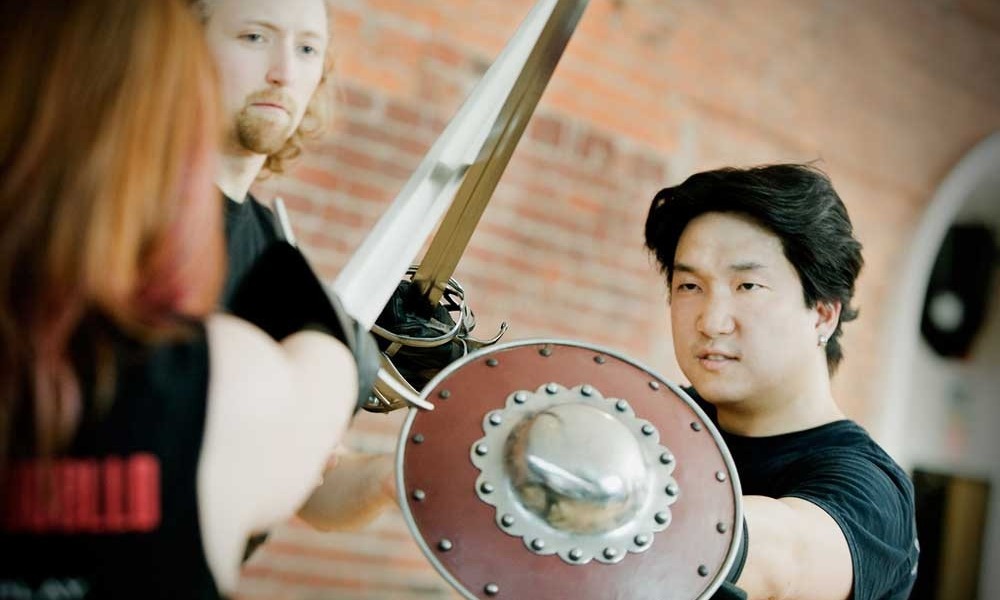Learning physical skills is a tricky thing. It’s important as a student that you’re practicing in the most effective and efficient manner for getting results in your desired performance environment (e.g. a duel, a tournament, a melee, etc.).
Two Types of Practice
There are two primary practice schema that can be applied when acquiring new skills:
- Blocked Practice
In Blocked Practice you learn skill A, then practice skill A over and over again in sequence.
- Varied Practice
In Varied Practice you learn skill A and skill B. You then alternate between practicing skills A and B.
Both of these types of training have their place.
Blocked Practice
Blocked practice is good for:
1. Establishing the foundations of a new motor program -- i.e. developing the general shape of a movement. You repeat the movement in a series to help create the correct motion before applying it in context or in varied practice.
2. Refining an existing motor program — here you take an existing technique but work on making it more accurate, efficient or powerful. Repeating the same action over and over without variability can allow you to focus on the various components of the movement.
3. Reprogramming an existing motor program — often we try to learn a new movement and find that an old movement is “in its way”. You could be learning a parrying technique with a new weapon, yet each time you attempt to execute it you use a parrying technique for a different weapon that you have learned before. Here, having a repeated presentation of the same action can help you set in place the new motor program and replace the old one (at least in this context.)
Blocked practice, however, does not help you to:
1. Mentally retain new skills. When you repeat a single action over and over again, then move onto a new action that you also repeat many times in succession, you may gain some physical conditioning but you are not putting your mind through the recall process, which is essential for long-term retention. It’s kind of like the experience of having someone direct you when you drive to their house, then realizing you have no recollection of the route you took.
2. Apply skills within a tactical environment. Repeating one technique over and over again does not develop your ability to choose that technique at the appropriate time or adapt the physical aspects of the technique to be successful in a performance environment.
This is where varied practice comes in. By asking your brain to recall a series of different techniques you reinforce the recall process and thus build up your ability to retain those skills.
Varied Practice
This can be done in a number of ways:
- Varied Practice in Series
This is essentially a more complex form of blocked practice. First learn skill A. Next, learn skill B. Then, practice A and B in an alternating series. Lastly, add in skill C and practice A, B, and C as a series. This form of exercise is not tactical (meaning you’re not making choices based on specific stimulus) but it does aid in retention and is useful for environments where a more simpler form of learning is needed. It also does well to reduce tactical stress.
- Tactical Variance
Here you learn a series of related skills within their tactical environment and then move between them based on stimulus. For example, you learn initially to parry on your right side. Once you've learned that, you are also taught how to parry on your left. Afterwards, you are queued in a random fashion with attacks to both right and left. This type of training is excellent because it does a better job of simulating the performance environment. Where it can be challenging is that it adds a type of mental complexity that can make it difficult for fencers who are not adequately familiar with the skills being drilled to either practice in a controlled fashion or build good movement habits. (For example, when a tactical element is introduced, some students respond too early with old motor programs, such as flailing instead of parrying.)
- Blocked and Varied Practice
In this hybrid approach you establish the general shape of movements through blocked practice and then help increase retention through varied practice. I recommend block practicing the movement in context, e.g. if you’re training a parry, make sure you’re learning it against an attack and not as an “in the air” movement against an imaginary opponent. Establish the skill and refine it mechanically, then add in the second skill and repeat the process. Once A and B are set, put them into a tactical variance. If mechanics break down, return to the blocked practice to correct them.
Varied practice is more complex and thus provides challenges for working on problems in mechanics (e.g. you’re doing the right parry at the right time, you’re just positioned incorrectly for it to be successful). Here, blocked practice can allow you to focus on the structure and order aspects required to succeed in the technique. Varied practice is, however, the required destination as it is far closer to a real combat environment, which is highly variable.
I have found it valuable in building my skills as a teacher and student to experiment with both of these methods and find how to best apply them in a learning environment. Be patient and thoughtful in your approach to learning. Impatience typically leads to a type of training blindness where you can train hard but not smart.
A special thanks to Luis Preto for further expanding my thinking on this topic.
